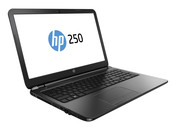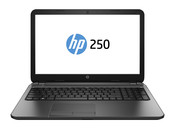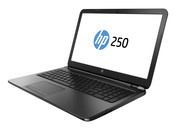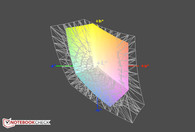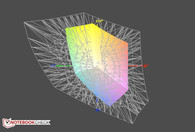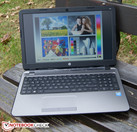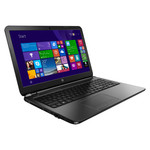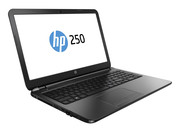HP 250 G3 Notebook Review

For the original German review, see here.
The HP 250 G3 steps on to the field as a notebook capable of performing simple office tasks for just 270 Euros (~$339). Its key hardware components consist of 2 GB of working memory, a 500 GB hard drive and an Intel Celeron N2830 with a clock speed of 2.16 GHz. It also comes with Windows 8.1 with Bing preinstalled. To position the 15.6-inch HP notebook relative to its competitors, we'll directly compare it with three devices in its price class. The Packard Bell EasyNote TF71BM comes outfitted with equivalent hardware, and is currently 20 Euros (~$25) cheaper than our HP device (~$314 total). At 260 Euros (~$326), the Acer Aspire E1-532 also costs slightly less, yet it boasts stronger Haswell architecture. In order to throw a non-Intel processor into the mix, we'll also compare our review device with the HP Compaq 15-h024sg.
Case & Connectivity
The HP 250 G3's case is constructed entirely of matte plastic. The raw surface doesn't show fingerprints and has good grippability. At a thickness of 2.8 cm (~1.1 inches) and a weight of 2.14 kg (~4.7 lbs), for having a 15.7-inch display, the device is very portable. Compared to the aforementioned competition, our device is 100-200 g (~0.22-0.44 lbs) lighter on average, but it is also 1-3 mm (~0.03-0.11 inches) thicker. The various pieces of the case join cleanly, but, unfortunately, the frame around the Ethernet port is rather sharp-edged, and the display lid yields easily to pressure. In terms of connections, the device offers three USB ports, though only one supports USB 3.0. Many other notebooks highlight their USB 3.0 ports in blue, but this HP device doesn't -- instead it simply houses the newer USB technology on its left side. With the exception of the power input and the Kensington lock, all the computer's connections are located towards the front. The advantage of this design is ease of accessibility; the disadvantage is that a tangle of devices and cables near the front of the notebook can get in the way, especially if you use a USB-based mouse.
Looking at the underside of the notebook, there is no maintenance hatch to be found. Only the battery can be removed without any tools. The Acer Aspire E1-532 proves that this kind of sealed construction isn't necessary for an inexpensive notebook.
Input Devices
Like most notebooks, our test device is outfitted with a chiclet keyboard. The keys are comparably flat and offer a very soft feel while typing. The positioning of the arrow keys takes a little getting used to, as the up and down arrows share one normal key space between the left and right arrows. A touchpad measuring 11.1 cm x 5.4 cm (~4.4 x 2.1 inches) with click keys below replaces the mouse. The pad generally executes multitouch commands, like scrolling on websites, very fluidly. All in all, both our notebook's input devices turned out well.
Display
The ergonomic, matte 15.6-inch TN display is a product of LG and has a resolution of up to 1366x768 pixels. The panel runs at an average brightness of 206 cd/m² in both AC power mode and battery mode. At 334:1, the contrast is exceptionally weak. Our test model's resulting black value is a high 0.67. HP's Compaq 15-h024sg proves that these things needn't be so -- with a contrast of 841:1 and black value of 0.24, it does considerably better here.
| |||||||||||||||||||||||||
Brightness Distribution: 87 %
Center on Battery: 225 cd/m²
Contrast: 336:1 (Black: 0.67 cd/m²)
ΔE ColorChecker Calman: 10.64 | ∀{0.5-29.43 Ø4.79}
ΔE Greyscale Calman: 10.61 | ∀{0.09-98 Ø5}
40% AdobeRGB 1998 (Argyll 1.6.3 3D)
42.92% AdobeRGB 1998 (Argyll 3D)
62.4% sRGB (Argyll 3D)
41.53% Display P3 (Argyll 3D)
Gamma: 1.99
CCT: 11338 K
Our analysis of the display's color and grayscale reproduction reveals further weaknesses. Both scales reach average DeltaE values of over ten, and the grayscale is plagued by a visible blue cast. The TN panel's viewing-angle stability is also pitiful. In outdoor use, the device scores points for its matte display, but because of its low brightness, the screen content is only visible on cloudy days.
Performance
The components HP chose for their inexpensive 270 Euros (~$339) notebook predestine the device for office and Internet use. If you're looking for more performance, the manufacturer also offers other hardware options for the 15.6-inch device. To upgrade the working memory size from 2 GB to 4 GB costs 50 Euros (~$62). Anyone who wants to add a higher-performance Intel Pentium N3530 (quad-core) will have to pony up a considerably larger sum (460 Euros; ~$577).
Processor
In order to keep their notebook in this low price range, HP installed an Intel Celeron N2830 dual-core processor. This CPU is usually found in smaller notebooks or netbooks and has a base clock frequency of 2160 MHz. In turbo mode, the CPU can clock at up to 2410 MHz. The Intel Celeron 2955U at work in the Acer Aspire E1-532 is based on Haswell architecture (rather than the HP device's Bay Trail architecture) and achieves considerably better results in our Cinebench test. However, with its AMD component, the HP Compaq 15-h024sg comes in far behind our Intel system here.
| Cinebench R11.5 | |
| CPU Single 64Bit (sort by value) | |
| HP 250 G3 | |
| Packard Bell Easynote TF71BM-C8R1 | |
| HP Compaq 15-h024sg | |
| Acer Aspire E1-532 | |
| CPU Multi 64Bit (sort by value) | |
| HP 250 G3 | |
| Packard Bell Easynote TF71BM-C8R1 | |
| HP Compaq 15-h024sg | |
| Acer Aspire E1-532 | |
System Performance
Our test device's reaction times are long. Subjectively, work seems to go more quickly on this machine than on the Acer Extensa 2509 we recently reviewed, although the Acer device managed to get better results in the PCMark 8 test.
| PCMark 8 - Home Score Accelerated v2 (sort by value) | |
| HP 250 G3 | |
| Packard Bell Easynote TF71BM-C8R1 | |
| Acer Extensa 2509-C052 | |
| PCMark 8 Home Score Accelerated v2 | 1226 points | |
| PCMark 8 Creative Score Accelerated v2 | 986 points | |
| PCMark 8 Work Score Accelerated v2 | 1300 points | |
Help | ||
Storage Devices
HP installed a 5400 rpm magnetic hard drive in their notebook. At 500 GB, the storage space is reasonably ample. The Hitachi Travelstar Z5K500's results are in the normal range for this kind of model.
Graphics Card
Our test notebook houses a Bay Trail version of Intel HD Graphics, directly integrated into the CPU. The Packard Bell EasyNote TF71BM is also outfitted with this GPU, whereas the rest of the competition diverges here: The Acer Aspire E1-532 boasts a Haswell version of the Intel HD Graphics, and the HP Compaq 15 has an AMD Radeon HD 8210 at its command. Both the Aspire and the Compaq offer considerably more performance in this area.
| 3DMark 11 - 1280x720 Performance (sort by value) | |
| HP 250 G3 | |
| Packard Bell Easynote TF71BM-C8R1 | |
| HP Compaq 15-h024sg | |
| Acer Aspire E1-532 | |
| 3DMark 11 Performance | 223 points | |
| 3DMark Ice Storm Standard Score | 15722 points | |
| 3DMark Cloud Gate Standard Score | 1194 points | |
Help | ||
Gaming Performance
Because the hardware's performance is so weak, it's better simply not to try to play new games on this system. Of course, some older games are surely playable at low graphics settings. The Acer Aspire E1-532 generates considerably more frames per second. Even so, the Acer device isn't capable of rendering games at more than minimum quality settings. If the user's list of musts includes the ability to run current games, a Geforce 840M is imperative -- even better would be a GTX 860M or above.
| Tomb Raider - 1024x768 Low Preset (sort by value) | |
| HP 250 G3 | |
| Packard Bell Easynote TF71BM-C8R1 | |
| Acer Aspire E1-532 | |
| low | med. | high | ultra | |
|---|---|---|---|---|
| Tomb Raider (2013) | 14.4 | 7.5 |
Emissions
System Noise
Even though our test device -- thanks to its fanless construction -- should theoretically be very quiet, the hard drive generates an audible noise. The loud whirring of a hard drive accompanied by its sharp clicking sounds could interfere with work-flow for those who are sensitive to such disturbances.
Noise level
| Idle |
| 0 / 0 / 0 dB(A) |
| HDD |
| 34.1 dB(A) |
| DVD |
| 37.2 / dB(A) |
| Load |
| 0 / 0 dB(A) |
 | ||
30 dB silent 40 dB(A) audible 50 dB(A) loud |
||
min: | ||
Temperature
Even without fans, the HP consistently remains cool in idle mode. The hottest spot (31.5 °C; 88.7 °F) is 2 °C or 3.6 °F hotter than the warmest areas on the competing devices, though these machines are outfitted with fans. Things get more interesting under load: At a maximum of 45.7 °C (114.26 °F), our HP notebook's highest temperature is considerably hotter than that of the competition. The Lenovo B50-30, which is also fanless, is more or less on par with our HP computer temperature-wise, but it remains somewhat cooler under load. Over the course of the stress test, our test device clocked at an average of 2223 MHz. Even after an hour under heavy load, the processor never dipped below its base clock frequency.
(+) The maximum temperature on the upper side is 39.5 °C / 103 F, compared to the average of 34.3 °C / 94 F, ranging from 21.2 to 62.5 °C for the class Office.
(-) The bottom heats up to a maximum of 45.7 °C / 114 F, compared to the average of 36.8 °C / 98 F
(+) In idle usage, the average temperature for the upper side is 26.3 °C / 79 F, compared to the device average of 29.5 °C / 85 F.
(±) The palmrests and touchpad can get very hot to the touch with a maximum of 36 °C / 96.8 F.
(-) The average temperature of the palmrest area of similar devices was 27.6 °C / 81.7 F (-8.4 °C / -15.1 F).
Speakers
A notebook in this price class is unlikely to offer great audio quality, and the HP 250 G3 is no exception. Bass is practically non-existent, and songs have a constricted and compressed sound. Music lovers are better off using headphones or plugging in external speakers. The volume is sufficient for the occasional film or YouTube clip.
Energy Management
Power Consumption
The notebook's power consumption rate in idle mode approximates its expected energy use in normal, everyday use as well. At 6.2 W to 10 W, the HP machine isn't especially thirsty, but the HP Compaq 15-h024sg and the Acer Aspire E1-532 consume around 2 Watts less. We simulate extremely heavy use (i.e. load) by running Furmark and Prime95 simultaneously. Our test device proves to require a low 15.4 Watts here; the Acer Aspire E1-532, with its Haswell architecture, needs a much higher 26.5 W.
| Off / Standby | |
| Idle | |
| Load |
|
Key:
min: | |
Battery Life
According to the manufacturer, the 28.8 Wh battery should have enough steam in it to run the machine for up to six hours. Our WLAN test simulates surfing the Internet at a display brightness of 151 cd/m². With a balanced Windows profile, our HP computer cuts out after just 3 h and 29 min. The competition offers considerably longer battery life.
Verdict
HP is asking for just 270 Euros (~$339) for their 15.6-inch notebook. The simple plastic case feels good in your hands, and the input devices are certainly cut out for office use and surfing the Internet. The keyboard feels good under your fingers, and the large multitouch pad reacts promptly and fluidly. In terms of the amount of noise the computer produces, its fanless construction does it credit and makes it possible to take this notebook into a quiet environment (ex. a library) without being a nuisance. However, the hard drive does generate sporadic, bothersome clicking sounds. Other cons include the computer's lack of performance and battery life. Compared to other devices, this notebook will need to be plugged into the wall after a fairly short period. The Packard Bell EasyNote TF71BM, for example, keeps chugging along for a whole 7 h. With its Haswell architecture, the Acer Aspire E1-532 offers better performance.
Considering its price, we'd call the HP 250 G3 a solid device. Even so, there are certainly good alternatives in this price range.




